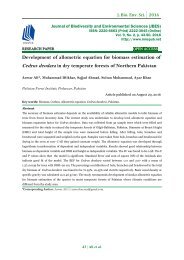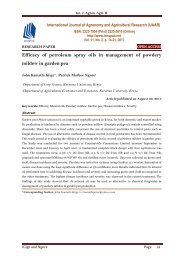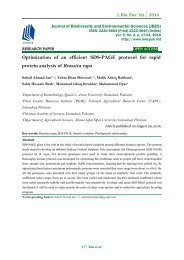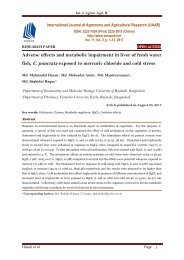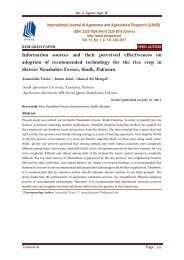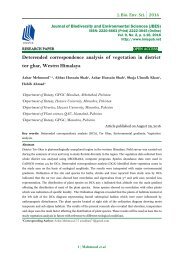Antidiarrhoeal activity of the leaf and fruit extracts of Dillenia indica
Abstract Plants are playing an important role in therapy of many diseases. Here we have studied on a plant which is Dillenia indica. In this study, ethanolic extract of the leaf and fruit of Dillenia indica was the experimental sample where antidiarrhoeal activity was analyzed. The plant parts showed antidiarrhoeal activity which was measured by castor oil induced method and charcoal plug method. In case of castor oil induced method the percent of inhibition of wet feces was measured and significantly decreased the total number of feces produced by the administration of castor oil; in 2nd hour (for leaf extract, 6 for 200 mg/kg dose and 4 at dose of 400 mg/kg and for fruit extract, 5.33 for 200 mg/kg dose and 4 at dose of 400 mg/kg) and 3rd hour (for leaf extract,3 for 200 mg/kg dose and 2 at dose of 400 mg/kg and for fruit extract 4 for 200 mg/kg dose and 3 at dose of 400 mg/kg). In charcoal plug method the activity was measured by distance traveled by the charcoal plug. The result was slightly lower than the control and the standard loperamide showed the maximum antidiarrhoeal effect. The average distance traveled by leaf was 28.67 cm and fruit was 22.67 cm which was lower than the control 41 cm where as the standard loperamide showed the average traveled length of 16 cm.
Abstract
Plants are playing an important role in therapy of many diseases. Here we have studied on a plant which is Dillenia indica. In this study, ethanolic extract of the leaf and fruit of Dillenia indica was the experimental sample where antidiarrhoeal activity was analyzed. The plant parts showed antidiarrhoeal activity which was measured by castor oil induced method and charcoal plug method. In case of castor oil induced method the percent of inhibition of wet feces was measured and significantly decreased the total number of feces produced by the administration of castor oil; in 2nd hour (for leaf extract, 6 for 200 mg/kg dose and 4 at dose of 400 mg/kg and for fruit extract, 5.33 for 200 mg/kg dose and 4 at dose of 400 mg/kg) and 3rd hour (for leaf extract,3 for 200 mg/kg dose and 2 at dose of 400 mg/kg and for fruit extract 4 for 200 mg/kg dose and 3 at dose of 400 mg/kg). In charcoal plug method the activity was measured by distance traveled by the charcoal plug. The result was slightly lower than the control and the standard loperamide showed the maximum antidiarrhoeal effect. The average distance traveled by leaf was 28.67 cm and fruit was 22.67 cm which was lower than the control 41 cm where as the standard loperamide showed the average traveled length of 16 cm.
Create successful ePaper yourself
Turn your PDF publications into a flip-book with our unique Google optimized e-Paper software.
Int. J. Biosci. 2011<br />
Discussion<br />
Crude ethanolic extract <strong>of</strong> leaves (both 200 mg/kg <strong>and</strong><br />
400 mg/kg dose) significantly decreased <strong>the</strong> total<br />
number <strong>of</strong> feces produced by <strong>the</strong> administration <strong>of</strong><br />
castor oil in 2nd hour (6 for 200 mg/kg dose <strong>and</strong> 4 at<br />
dose <strong>of</strong> 400 mg/kg) <strong>and</strong> 3rd hour (3 for 200 mg/kg<br />
dose <strong>and</strong> 2 at dose <strong>of</strong> 400 mg/kg) which was<br />
comparable to <strong>the</strong> st<strong>and</strong>ard drug Loperamide (% <strong>of</strong><br />
inhibition was 72.67 at 2nd hour <strong>and</strong> 85.67 at 3rd<br />
hour).<br />
suspension in 10% aqueous suspension <strong>of</strong> charcoal<br />
powder orally. 45 minutes after treatment <strong>the</strong><br />
abdomen was cut <strong>of</strong>f <strong>and</strong> <strong>the</strong> small intestine carefully<br />
removed. The distance traveled by charcoal plug from<br />
pylorus to caecum was measured, <strong>and</strong> expressed as<br />
percentage <strong>of</strong> <strong>the</strong> distance traveled by charcoal plug for<br />
each <strong>of</strong> animal.<br />
Table 5. Mean distance traveled by charcoal plug <strong>and</strong><br />
% <strong>of</strong> deviation from control.<br />
Crude ethanolic extract <strong>of</strong> <strong>fruit</strong>s (both 200 mg/kg <strong>and</strong><br />
400 mg/kg dose) significantly decreased <strong>the</strong> total<br />
number <strong>of</strong> feces produced by <strong>the</strong> administration <strong>of</strong><br />
castor oil in 2nd hour (5.33 for 200 mg/kg dose <strong>and</strong> 4<br />
for 400 mg/kg dose) <strong>and</strong> 3rd hour (4 for 200 mg/kg<br />
dose <strong>and</strong> 3.33 for 400 mg/kg dose) which was<br />
comparable to <strong>the</strong> st<strong>and</strong>ard drug Loperamide (% <strong>of</strong><br />
inhibition was 72.67 at 2nd hour <strong>and</strong> 85.67 at 3rd<br />
hour). Fur<strong>the</strong>r investigation is necessary to isolate <strong>the</strong><br />
active principles from this plant.<br />
<strong>Antidiarrhoeal</strong> <strong>activity</strong> by charcoal plug method<br />
The antidiarrhoeal <strong>activity</strong> <strong>of</strong> <strong>the</strong> <strong>extracts</strong> may be<br />
related to an inhibition <strong>of</strong> muscle contractility <strong>and</strong><br />
motility, as observed by <strong>the</strong> decrease in intestinal<br />
transit by charcoal meal <strong>and</strong> consequently, in a<br />
reduction in intestinal propulsion. Mices were fasted<br />
for 18 h. They were divided into four groups. The first<br />
group which served as control was. The second group<br />
receives st<strong>and</strong>ard drug loperamide. The extract was<br />
administered orally at 200 mg/kg (<strong>leaf</strong>) to third group<br />
<strong>and</strong> 200 mg/kg (<strong>fruit</strong>) to fourth group as suspension.<br />
The animals were given 0.3 mL <strong>of</strong> a 5% charcoal<br />
44 Rahman et al.<br />
Fig. 1. % <strong>of</strong> inhibition <strong>of</strong> wet faces at different hours by<br />
different groups.<br />
Fig. 2. % <strong>of</strong> deviation <strong>of</strong> motility in different groups<br />
(<strong>the</strong> more <strong>the</strong> deviation from control <strong>the</strong> better <strong>the</strong><br />
action <strong>of</strong> drug as motility inhibitor).<br />
The average distance traveled by <strong>Dillenia</strong> <strong>indica</strong> <strong>leaf</strong><br />
(mean 28.67 cm) <strong>and</strong> <strong>fruit</strong> (mean 22.67 cm) extract<br />
was lower than <strong>the</strong> control (mean 41 cm) where as <strong>the</strong><br />
st<strong>and</strong>ard loperamide showed <strong>the</strong> average traveled<br />
length <strong>of</strong> 16 cm.<br />
Crude ethanolic extract <strong>of</strong> leaves at 200 mg/kg body<br />
weight fraction showed significant <strong>activity</strong> on reducing<br />
<strong>the</strong> motility <strong>of</strong> Gastro intestinal tract <strong>of</strong> mice with -


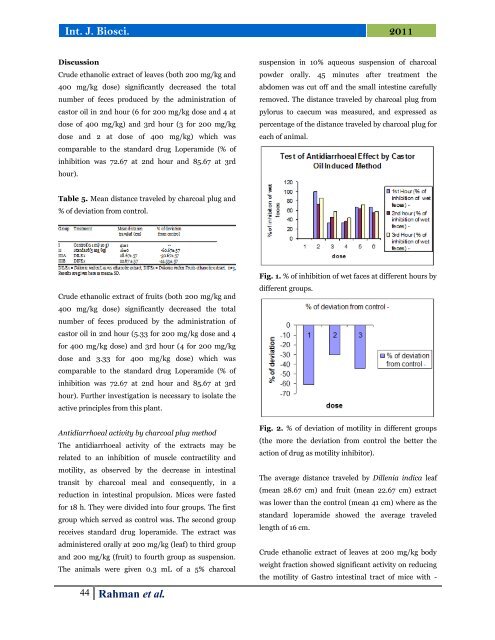


![Review on: impact of seed rates and method of sowing on yield and yield related traits of Teff [Eragrostis teff (Zucc.) Trotter] | IJAAR @yumpu](https://documents.yumpu.com/000/066/025/853/c0a2f1eefa2ed71422e741fbc2b37a5fd6200cb1/6b7767675149533469736965546e4c6a4e57325054773d3d/4f6e6531383245617a537a49397878747846574858513d3d.jpg?AWSAccessKeyId=AKIAICNEWSPSEKTJ5M3Q&Expires=1727215200&Signature=%2FREK6zszLKhLa8%2BzBN0UU3PJXcA%3D)







